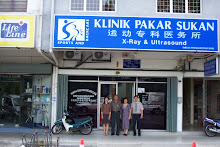GOLFER’S elbow is a common affliction and is characterised by the pain on the medial (inner) side of the elbow. It is also known as Medial Epicondylitis. Golf and racquet sports are prone to this condition. When the elbow pain is on the outer side (lateral) of the elbow joint then the condition is often refer to as Tennis elbow.
After a 15-year of inactivity, Mr. Lee is advised by his doctor to exercise in order to keep his hypertension in check. So he took up golf again. “I met one of my friends who have been playing golf when I made a visit to the driving range recently. So I got back into the game” said the 45-year-old project manager.
Mr. Lee started playing golf, regularly two to three times a week at the local club and two times at the driving range. From an initial 100 to 150 balls per session, he quickly increased to 300 balls at each session. After three months, Mr Lee felt a twinge around his elbow but ignored it. He took some pain killer and continued playing golf. The pain increased until a stage when he couldn’t even pick up the club. By this time, his blood pressure had been brought under control and his weight had gone down. But he had suffered an elbow injury.
Golfer’s elbow is more common among people between the ages of 35 and 50. The muscles and tendons of younger people are more flexible and less prone to this type of injury. Golfer elbow’s is an inflammation of the muscle and tendons in the forearm attachment to the elbow bone. The elbow injury can be caused by physical work or sports activities. Other then golf and racquet sports, activities that require prolonged gripping such as hammering, driving screws, weight lifting, playing certain musical instruments and gardening can cause this condition too. Golfer who worked with free weights and resistance machines are also at increase risk of this injury.
In the case of Mr Lee, small tears to the tendons can occur as a result of overuse and the condition may persist for months. However, not all elbow pains are caused by tendonitis as there could be a tear in tendon and muscle when you hit the carpet, on the ground or tree root. The tendon may not be able to heal, or may heal very slowly over many months. The slow process of healing may have to do with poor circulation, but also because the area is stretched and twisted by normal movement of the elbow, making it hard for irritated areas to rest.
The symptoms of golfer’s elbow
- Pain after or during playing golf.
- Pain on the inner area of the elbow.
- Elbow pain may radiate up and down the arm.
- Weakness in the wrist and arm when carrying heavy thing.
- Pain caused by touch over the inner part of elbow.
- Swelling on the side of the elbow.
- Pain exacerbated by gripping activities like holding the handle of the club.
- Pain when turning a door handles or water tape.
- Pain when fully flexing the elbow.
Golfer with elbow pain should immediately stop whatever activity they are doing which is painful. In some golfers, temporarily resting the arm is enough to allow the elbow injury to recover after one to two months. However, sometimes this pain can almost recur immediately when they resume their golf. To get a more permanent cure, I would recommend a total layoff temporary followed by treatment and rehabilitation.
Proper treatment begins with the early detection of the injury. Left untreated, golfer’s elbow can last six months or longer. When treated early, sufferers enjoy a better chance to return to their golf and sports activities early.
Early treatment begins with treatment with ice and active rest. Non-steroidal anti-inflammatory drugs may be taken to help reduce the swelling and inflammation that accompanies this injury during the early phase. Active rest is vital to aid the recovery process. Elbow brace and band provided temporarily relief of pain.
Active rest involves avoiding the exercises or movements that exacerbate the pain. Keep fit with alternative exercise like running, swimming, cycling on stationary bicycles, brisk walking or aerobic class.
Do specific exercises designed to improve the flexibility and strength to the wrist and elbow when the pain subsides. A combine rehabilitation program will improves and speeds up recovery. Last, but not least, return to golf slowly and gradually increase your play.
Tips for golfer:
- Stretch your elbow before and after.
- Proper warm up and cool down.
- Avoid hitting more then 100 balls at driving range per session.
- Avoid consecutive day play.




Tennis Elbow? How did I get it? How do I get rid of it?
ReplyDeletecopper elbow sleeve review
It was another joy to see your post. It is such an important topic and ignored by so many, even professionals. I thank you to help making people more aware of possible issues. Great stuff as usual...
ReplyDeleteconcrete repairs